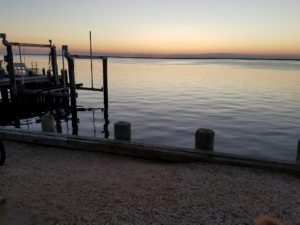
I found a message in a bottle when I was a kid.
Or more precisely, my friend Linda spotted it first. It was floating in Barnegat Bay, a five-mile wide arm of the Atlantic between Long Beach Island, New Jersey and the mainland. On one of the island’s bay accesses, we had lowered our crab traps off the bulkhead in the hopes of catching some dinner. That’s when Linda spotted it bobbing in the water.
“Look, a message in a bottle!”
A flying leap for a bottle

Fully clothed, I leapt off the bulkhead, ponytail flying and limbs splayed. It was a five-foot drop, and the water was about just as deep, but I could swim. I stroked over to the bottle, grabbed it, and then clambered back up the bulkhead with our treasure.
Linda and I examined it. The message was rolled and tied with a cord. A thick layer of olive-green wax around the cap rendered the bottle waterproof. It was so thick we couldn’t uncap the bottle.Linda and I dashed home, grabbed a pruning knife, and began slicing the wax off layer by layer over the kitchen garbage can. I trembled with excitement as I dripped water all over the kitchen floor. Was the bottle a cry for help? Did it contain a secret message from pirates?

A message in a bottle as scientific research?
What we read once we slipped the scroll out and untied it couldn’t have been more disappointing for two ten-year-old kids. It was from someone researching ocean currents. It would have been exciting if the bottle had come in from England or India, but according to the message, it had been dropped into the Little Egg Harbor Inlet only four hours before, on the same day. That was less than ten miles away. Whoever did it hadn’t even bothered to check the tide tables before tossing the bottle into the sea. The tide brought the bottle inland, into the bay, not out into the ocean.
Nevertheless, Linda and I dutifully filled out the accompanying questionnaire about when and where we found the bottle. It asked for our addresses, and we gave them. It was yet another childhood disappointment that the researcher never wrote back to thank us. (If you happen to be reading this blog, and you were the one doing ocean current research in the late sixties or early seventies on Barnegat Bay, it’s not too late. Please drop me a line via the contact form on my blog or leave a comment and I’ll make sure Linda gets it too.)
A message in a bottle as a lead in a criminal investigation?
Some messages in bottles are much more ominous than the one we found.
Paul Brown has been collecting historical messages in bottles around the world. The messages come from the newspaper archives. Found messages were regularly printed in newspapers, often in a column titled “Messages from the Sea”, which is where the name of the book comes from. Before the wireless telegraph, the message in a bottle was a useful and legitimate means of communication. It was often the intention of senders to have their message published in newspapers. They knew the messages would eventually be washed ashore, and that their message might reach loved ones and other recipients.
Brown recently wrote a book about his finds. Messages from the Sea is scheduled for publication in September 2016. A few of the messages in his book contained clues to crimes: murders, kidnappings, and body snatchings. Paul joins us today with a guest blog about what must be the most romantic kind of crime clue ever: the message in a bottle.
Here’s Paul Brown:
________________________________
Messages from the Sea: A Guest Blog by Paul Brown

A message in a bottle as a clue to a murder?
On September 17, 1889, a man named Samuel McAfee found a message in a bottle floating in Albert Quay, Belfast, Northern Ireland. McAfee passed the message, written on a slip of paper, to the harbor police. The message read as follows:
“Look out for the body of a man in the Blackstaff who committed murder and suicide, and also for the murdered man. 6 p.m. 10/8/89.”
The words “murder and suicide” were written in red ink, and the handwriting was said to be “stiff and cramped”. The Blackstaff is an underground river in Belfast that was culverted and built over in the 1880s. The message was initially assumed to be a hoax “intended by some mischievous person.” However, as a local newspaper noted: “When taken into account that a body was seen floating in the quay about a fortnight ago, the strange find may possibly bear some significance.”

All sorts of messages
This mysterious message is one of 100 collected in the Messages from the Sea book, based on the website of the same name. Dating from the late 19th and early 20th centuries, these letters and notes were found on beaches and bobbing in rivers, in corked glass bottles and wax-sealed boxes, inside the mouths of codfish and in the bellies of sharks, carved on pieces of wrecked vessels and attached to the necks of seabirds. They tell tales of foundering ships, missing ocean liners, and shipwrecked sailors, and contain moving farewells, romantic declarations, and intriguing confessions.
Often written in the most desperate of circumstances, many of the messages are starkly moving. One such message, found on the northwest coast of England in 1907, reads: “Finder please give this to relatives of Bertha Magnussam, Wavertree, Liverpool, England. Love from Hubert, and good-bye.” Other messages provide clues regarding disappeared vessels. We know what happened to the Titanic – from which several messages in bottles were apparently cast adrift – but what happened to fellow White Star liner the Naronic, or the Collins liner Pacific?
Some of the messages concern murders, kidnappings, body snatchings, and mysterious family secrets. Who was Charles Pilcher, and did he really murder Margaret Hutchinson and put her body in a well? Did Elizabeth Granton find the “secret of her birth”, which a message in a bottle said was hidden behind a picture of the Earl of Warwick? And who was the sender of the message in a corked bottle, written in pencil on a neatly rolled-up piece of paper, which claimed responsibility for the unsolved murder of noted artist Archibald Wakley?
A floating message as the key to a miner’s demise?
And what of the message found floating in Snake River at Weiser, Idaho, in April 1897? It read: “I was shot last night by an unknown party. I am mining on Snake River at Big Bend. I am dying. Yours, W. C. Cook.” It was known that Snake River’s gold deposits attracted many placer miners, most of whom who lived and worked alone along the river. And, ten days previously, an attempt to murder one of these miners, and to steal his gold, had been made at another point in the river. That victim had been left for dead but survived. W. C. Cook was never traced, and local newspapers speculated that he might not have been so lucky.

Messages from the Sea: Letters and Notes from a Lost Era Found in Bottles and on Beaches Around the World is available as a special limited edition hardback from www.messagesfromthesea.com.
Paul Brown is a writer who lives on the northeast coast of England. He can be found on Twitter @paulbrownUK and at www.stuffbypaulbrown.com.
__________________________________
Thank you, Paul Brown!




What a fascinating subject for a book.
I agree! I wish I had thought of it myself, and I wish Paul Brown all the luck in the world with his book. Thanks for commenting, Susan.
Great pictures! That IS a great idea for a book.
Thanks, Jacqueline, for your compliment on the pictures. I was thinking that would make a great book to read on the beach. Don’t you think? It would get everyone out of their beach chairs to comb the beach for bottles.